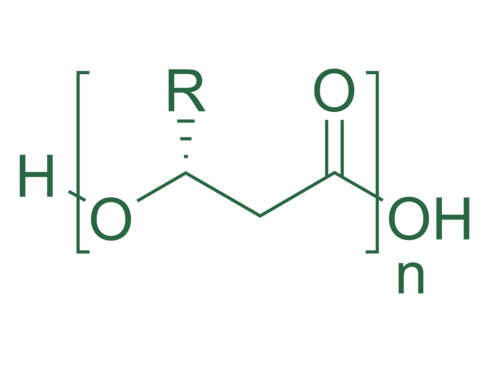
Polymer Composites with Biodegradable PHA
Global Production of PHA
This week featuring the biopolymer shooting stars Polyhydroxyalkanoates (PHA) and their composites! A short glance on the market perspectives of PHA: Today, PHA is a niche inside the biopolymers niche, accounting only for ~2% of global production. However, shooting stars is not without meaning. Already in 2025, the production share could reach 11% of an ever-growing biopolymer market!
The PHA Family
Talking about PHA is like explaining a huge patchwork family structure.
Various microorganisms produce PHA via enzymatic synthesis where they convert sugars or fatty acids. The bacteria need specific deficiency conditions paired with an excess of carbon source to induce the synthesis of PHA. Hereby, the cultivation conditions and type of organism determine the PHA composition, always based on the following structure:
Depending on the R moiety, the polyester properties vary greatly and result in elastomeric or thermoplastic materials. Those homopolymers also are combined in an arbitrary amount of copolymers.

PHA - Versatile and Promising!
As mentioned, the polymerization varieties make PHA highly variable materials. The copolyester PHBV for example shows good barrier properties against oxygen and water vapor, while PHBHB performs significantly worse.
Generally, PHAs are brittle polymers with relatively high molecular weight. In certain applications, e. g. packaging materials, they have the potential to substitute conventional polypropylene and contribute to a sustainable economy.
Taking a glance on biodegradability, PHAs show huge potential in end of life options for compostability. Compared with the most prominent biopolymer PLA, PHAs are easily degradable. Hence, combining PHA with JRS natural fibers is not mainly done for improving biodegradable properties, but to enhance mechanical parameters like Heat Deflection Temperature and E-modulus.
Regarding the processing of PHA with natural fibers, it is the same as with last week's PLA. The moisture of plant based products can cause hydrolysis under plastification conditions.
To reduce or neglect hydrolysis, screw configuration should be adjusted and the fibers preferably added over a side feeder at the latest possible point to reduce the dwell time. Favorable equipment, with low dwell time and good de-gassing, are co-rotating twin screw, planetary roller and multi-rotation extruder. Also pre-drying of the polyester and plant based fillers can be necessary.
Please contact us for any questions or comments!








